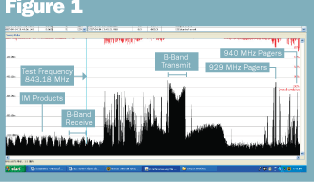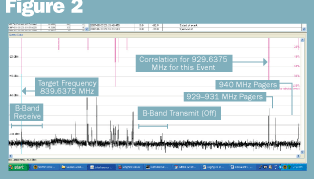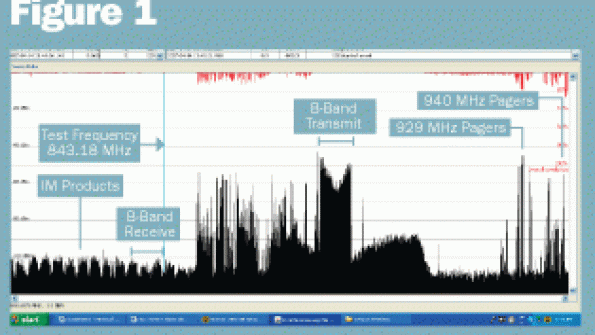Solving intermodulation interference
Part 2 of 2
Last month we laid the groundwork for understanding intermodulation interference at co-location sites. This month we’ll illustrate some common problems with real-world examples and suggest some practical solutions.
Example 1: Interference from AM station. It may be hard to believe, but an AM station operating at 1040 kHz actually caused interference to a U.S. Postal Service repeater operating in the VHF band. The USPS repeater transmitted on 164.175 MHz and received on 166.250 MHz, and it employed a private line (PL) tone. The symptom resembled a stuck microphone. After the first user keyed his or her portable radio, the repeater remained keyed indefinitely. Users could hear white noise in the background and assumed the repeater was busy and unavailable. In reality, a modest uplink signal would re-capture the repeater, but users were not aware of this fact and assumed the repeater was unusable.
An AM broadcast tower, operating on 1040 kHz, was located a few blocks from the post office. A quick look at potential IM products revealed the following: 164.175 + 2(1.040) = 166.255 MHz, only 5 kHz from the repeater receive frequency. Because the repeater employed good filters and a ferrite isolator, the consulting engineer concluded that the likely source of the IM product was passive IM in the repeater’s antenna. The IM product did not create enough distortion to significantly alter the PL tone, so the site receiver always detected a valid tone and kept the repeater keyed. The antenna had recently been replaced to no avail and there was no enthusiasm for a second replacement, so the radio shop programmed different PL tones on the transmit and receive frequencies and the problem disappeared.
Example 2: Channel 23 (TV) interference to GPS L1 channel. The Global Positioning System (GPS) employs two main radio channels, L1 and L2. Civilian GPS receivers rely primarily on the L1 channel, which is a 1 megachip per second spread spectrum signal centered on 1575.47 MHz. A mountaintop site in Colorado is home to both Channel 23 and a nationwide paging company that uses GPS to synchronize its simulcast paging network. The visual carrier for Channel 23 is 525.25 MHz, and the third harmonic of this carrier is 1575.75 MHz, well within the 1 MHz bandwidth of the L1 channel. Immediately after Channel 23 went on the air, the paging station lost synchronization and the company’s technician called the consulting engineer for help. A better lowpass filter on the Channel 23 transmitter helped somewhat, but the problem persisted because the GPS receiver did not adequately filter the television signal and the third harmonic of Channel 23 also was created in the receiver front end. The receiver was replaced with one that included a better front end filter. Note that in this case, both transmitter-generated harmonics and receiver-generated harmonics existed. There is not always a single source of IM interference.
The second harmonic of the aural carrier of Channel 66 (TV) falls on 1575.5 MHz, and it also can interfere with GPS L1 receivers.
Example 3: 900 MHz pager interference to the B-band cellular operator. This problem occurred at two different cell sites, and although 900 MHz pagers were involved in both cases, the physical interference mechanism was quite different at each site.
It is fairly well known in the cellular industry that paging transmitters operating in the 929-932 MHz bands can cause interference to the B-band cellular operator. The B-band operator receives in the bands 835-845 MHz, 846.5-849 MHz and transmits in the bands 880-890 MHz and 891.5-894 MHz. Many B-band operators employ the TIA-95 CDMA airlink standard with 1.25 MHz-wide channels. If one of these CDMA carriers is transmitting on 886.44 MHz and a nearby paging transmitter is operating on 929.5625 MHz, a potential IM product results: 2(886.44) – 929.5625 = 843.3175 MHz, which falls in the reverse link band of the cellular operator. Because the transmit signal is 1.25 MHz wide, the IM product will be at least 1.25 MHz wide (closer to 2.5 MHz in this case) and at least two CDMA receive channels are affected by this interference.
At the first site, the interference was intermittent and the consulting engineer set up an automated test with a spectrum analyzer connected to the diversity antenna on the affected sector. The control software was set to store each trace whenever energy appeared above a pre-determined threshold on a frequency known to be out-of-service. Figure 1 shows a spectrum analyzer trace for an interference event at this site. Note that the interfering signals are similar to individual CDMA carriers, but roughly twice as wide and with a more rounded shape.

This wider bandwidth and rounded shape is consistent with the second harmonic of a CDMA signal. Note that interferers appear at regular intervals and the interference extends well below the cellular operator’s receive band. The reader will also notice a notch exists in the B-band transmit spectrum. This notch is from a notch filter inserted in front of the spectrum analyzer to suppress the transmit signals and thereby prevent the analyzer front end from being driven into saturation.
Further tests showed that the IM products at this site only occurred when the cellular operator was transmitting. After eliminating both transmitter intermodulation and receiver intermodulation as sources, the operator concluded that the cellular antennas were generating passive IM and should be replaced.
The second site is congested with FM broadcast, TV broadcast, VHF repeaters, UHF repeaters, 800 MHz public safety radio, 800 MHz ESMR, 800 MHz cellular, 900 MHz paging and PCS. There are 14 paging transmitters at this site, and measured levels at the affected sector antenna (before filtering) are as high as 0 dBm. The paging antennas are less than 50 feet from the B-Band sector antennas. Unlike the first site, interference at this site was still present when the cellular operator was not transmitting. Also, the interference was narrowband. (See Figure 2.)

An examination of the data showed that the interference always fell exactly 90 MHz below one of three 929 MHz or 931 MHz paging frequencies in use at the site. Further investigation revealed that the paging transmitters employed a 90 MHz intermediate frequency and upconverted the signal from there. Thus, either the local oscillator for the upconversion or an IM product was the source of the interference. The paging transmitters lacked adequate bandpass filters which would have prevented this problem. It is interesting to note that the cellular antennas at the second site were exposed to much higher levels from paging transmitters than at the first site, but they did not create passive IM interference. Thus, the level of PIM rejection differs widely between manufacturers.
Example 4: Image frequency interference to public-safety receiver. Image frequency interference is a form of receiver IM that often is overlooked. Consider a superheterodyne receiver with a first IF of ƒIF tuned to frequency ƒRF. The local oscillator (LO) frequency is either LO = ƒRF + fIF or LO = ƒRF – ƒIF, depending on the receiver design. An image frequency, ƒIMAGE, is an undesired frequency that is exactly 2 ƒIF above or below the tuned frequency, ƒRF, for LO frequencies below or above the tuned frequency, respectively. For the most part, the mixer does not distinguish between a tuned frequency and an image frequency and it will generate an IF signal from either. The key to eliminating image frequency interference is to employ a good filter at the receiver front end to attenuate the image frequency.
Consider this example: If the tuned frequency is 807.25 and the IF is 45 MHz, the image frequency is 807.25 – 2(45) = 717.25, which is the visual carrier for Channel 55 (TV). Thus, if the receiver front-end filter does not adequately attenuate 717.25 MHz and the television visual carrier is strong, harmful image frequency interference will occur. Of course, image frequency interference from analog television transmitters operating on Channel 55 will not exist after Feb. 17, 2009, when the digital television transition is complete and all television stations will be digital and will be confined to Channels 2-51 (with a few exceptions).
Jay Jacobsmeyer is president of Pericle Communications Co., a consulting engineering firm located in Colorado Springs, Colo. He holds bachelor’s and master’s degrees in electrical engineering from Virginia Tech and Cornell University, respectively, and has more than 25 years experience as a radio frequency engineer.

















